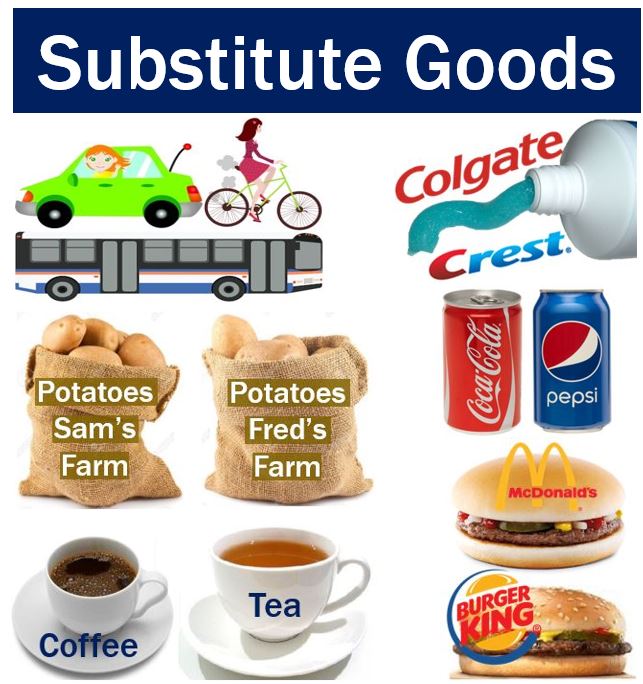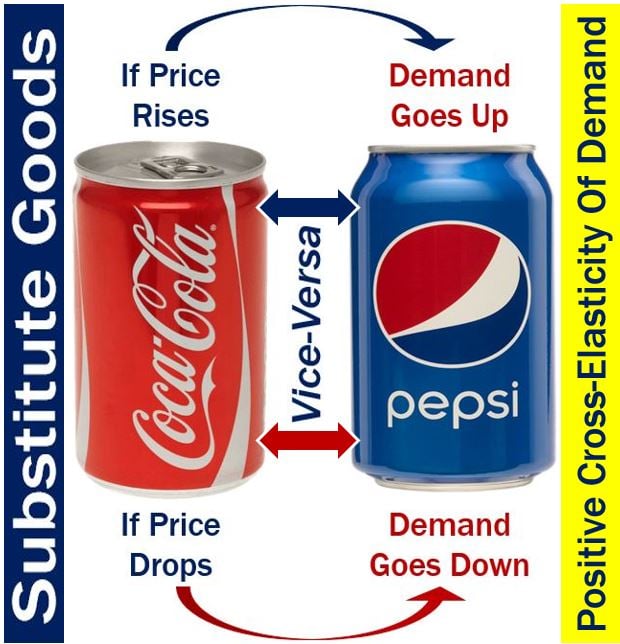Substitute Goods or Substitutes are at least two products that could be used for the same purpose by the same consumers.
If the price of one of the products rises or falls, then demand for the substitute goods or substitute good (if there is just one other) is likely to increase or decline. The other products – the substitutes – have a positive cross-elasticity of demand.
The availability and accessibility of substitutes can significantly influence consumer loyalty and purchasing patterns, as buyers readily switch to alternatives when faced with price changes or supply constraints.
Substitute goods are identical, similar, or comparable to another product, in the eyes of the consumer.
Substitute goods can either fully or partly satisfy the same needs of the customers. Therefore, they can replace one another, so the consumer believes.
Pepsi-Cola is a substitute good for Coca-Cola, and vice-versa. When the price of Coca-Cola goes up, demand for Pepsi-Cola will subsequently rise (if Pepsi does not raise its price).
According to the Cambridge Dictionary, substitute goods are:
“Products that can satisfy some of the same customer needs as each other. Butter and margarine are classic examples of substitute goods.”
If someone doesn’t have access to a car they can travel by bus or bicycle. Buses or bicycles, therefore, are substitute goods for cars. Substitute goods are two or more products that the consumer can use for the same purpose.

Examples of substitute goods
Below is a list of some common substitute goods:
- Coke & Pepsi
- McDonald’s & Burger King
- Colgate & Crest (toothpaste)
- Tea & Coffee
- Butter & Margarine
- Kindle & Books Printed on Paper
- Fanta & Crush
- Potatoes in one Supermarket & Potatoes in another Supermarket.
- Streaming Services (Netflix & Hulu or Amazon Prime)
- Electric cars & Gasoline Cars
- Soy milk & Almond Milk
McDonald’s and Burger King’s hamburgers both satisfy the consumer’s requirements of being served rapidly and relatively cheaply.
The price of Burger King’s hamburgers has a direct effect on demand for those of McDonald’s, and vice-versa. They satisfy the positive cross-elasticity component of demand for substitute goods.
If one product responds immediately to a change in price to another – if demand rises by the same percentage as the others’ price increase – it is a ‘perfect substitute’ or ‘close substitute.’ If the cross-elasticity is slight – if a 20% increase in the price of one leads to just a 1% rise in demand for another – it is known as a ‘weak substitute.’

The definition of a ‘perfect substitute’ is all down to the preference of the consumer. If I receive the same satisfaction from Coke as I do from Pepsi, they are perfect substitutes. If you think one tastes better than the other, then Pepsi is a ‘near-perfect substitute’ for Coke, or vice-versa.
More Diverse Examples of Substitute Goods
Substitute goods exist in virtually all industries, not just among everyday consumer products like beverages or fast food. Here are additional examples from various sectors:
Technology: The rivalry between Microsoft Windows and Apple’s macOS represents a key example of substitute goods in the computing industry. Both operating systems serve the same core purpose—allowing users to run programs, browse the internet, and manage files—but cater to different preferences in terms of user interface, design philosophy, and integration with other devices.
Streaming Services: Netflix and Disney+ are examples of substitutes within the streaming industry. While both offer on-demand video content, the choice between them often hinges on the specific shows and movies they offer, pricing, and added benefits like family-friendly options or exclusive series. Additionally, these services function as alternatives to traditional cable or satellite TV, giving users more flexibility over what they watch and when.
Transportation: Electric scooters, such as those provided by companies like Lime or Bird, are substitutes for traditional forms of short-distance transportation, like bicycles, walking, or public transport. People may opt for scooters over buses or taxis for convenience, cost, or the environmental benefit of using an electric vehicle.
Energy: Solar power and wind power are close substitutes in the renewable energy sector. Both provide sustainable alternatives to fossil fuels but differ in terms of geographic feasibility, upfront installation costs, and ongoing maintenance. For instance, solar power is more viable in regions with high sun exposure, while wind power is more effective in areas with consistent wind patterns.
Luxury Goods: In the high-end automobile market, brands like Mercedes-Benz and BMW offer substitute goods. Both are premium brands that appeal to consumers looking for luxury vehicles, but the decision often comes down to factors like driving experience, technology features, and brand perception.
Healthcare: Generic drugs are substitutes for brand-name medications. While they contain the same active ingredients and provide the same therapeutic effects, generic drugs are typically much cheaper. Consumers and healthcare providers often opt for generic alternatives as a way to reduce healthcare costs without sacrificing treatment quality.
By broadening the range of examples, it’s clear that substitute goods influence decision-making across industries, whether in daily consumer choices or high-cost sectors like energy and healthcare.
Impact of Digital Goods as Substitutes
The rise of digital platforms has dramatically expanded the scope of substitute goods, offering consumers new options that challenge traditional products and services.
Music: Music streaming services like Spotify and Apple Music have largely replaced physical formats like CDs or digital downloads. By offering access to vast libraries of music for a subscription fee, these platforms make purchasing individual albums or songs far less appealing to many listeners. The ability to discover new music, create personalized playlists, and listen on multiple devices adds to their attractiveness as substitutes.
Education: Online learning platforms, such as Coursera and Udemy, provide a viable alternative to traditional education. These platforms offer flexibility in scheduling, lower costs, and a wide range of courses that appeal to individuals looking to upskill without committing to a full-time degree program. In particular, professionals seeking certifications in specific fields, like coding or data analysis, may find these online courses to be a suitable replacement for formal education.
Publishing: E-books and audiobooks, available through platforms like Amazon Kindle or Audible, are substitutes for physical books. These digital alternatives offer portability, convenience, and often lower prices, reshaping how people consume literature. While some readers prefer the tactile experience of printed books, the accessibility of digital versions appeals to those who prioritize convenience and space-saving.
Retail: E-commerce platforms like Amazon and Walmart.com serve as substitutes for physical stores, offering a similar range of products but with added convenience. Online shopping allows consumers to compare prices more easily, read reviews, and have items delivered directly to their homes, reducing the need for in-person visits to stores. This has been especially impactful in reshaping consumer behavior during busy shopping seasons and in areas with limited access to large retail outlets.
The increased availability of digital substitutes has transformed the marketplace by giving consumers more choices and flexibility in their consumption habits. As these digital goods continue to evolve, their role as alternatives to traditional products and services will likely grow, further influencing consumer preferences and industry competition.
Direct and indirect competition
Close substitute goods are in indirect competition, i.e., they are similar products that target the same customer group and satisfy the same needs.
For example, a frozen yogurt shop and an ice cream shop sell different goods. However, they both target people who are hungry and want something sweet and cold. Therefore, they are in indirect competition. They are indirect competitors.
A frozen yogurt shop sells the same goods as another frozen yogurt shop nearby. They are in direct competition. They are direct competitors.
Similarly, online marketplaces and traditional brick-and-mortar stores often find themselves in indirect competition, as both aim to satisfy the consumer’s desire for convenient shopping experiences, albeit through different mediums.
Substitute goods and monopolistic competition
In several markets for commonly-purchased goods, some products are perfectly substitutable yet are branded and marketed differently. We refer to this condition as monopolistic competition.

Imagine that the price of a can of Coke increases from P1 to P2. People would consume less Coke – the quantity declines from Q1 to Q2. For a can of Pepsi – the substitute good – the demand curve shifts out for all price levels, from D to D1, leading to a greater consumption of the substitute good. (Image: adapted from Wikipedia)
Let’s consider, for example, the comparison between a name brand and generic version of a medication. The two products may be identical, they have the same **active ingredient – they are substitute goods. However, their packaging is quite different.
** The active ingredient is the part of a compound or substance that produces its biological or chemical effect. In other words, it treats, relieves, or cures the patient’s illness or condition.
As the two goods are essentially identical, the only genuine difference between the two medications is the price. In other words, the two vendors depend mainly on branding and price respectively to achieve sales.
The Five Forces
Substitute goods are one of the Five Forces. The other four are:
- existing customers,
- new customers,
- barriers to entry, and
- suppliers.
The five forces are external factors that tell us how viable, i.e., how profitable, an industry is. When a business is viable, we expect it to make a profit year after year.
The proliferation of digital platforms and e-commerce has introduced virtual goods and services as substitutes, significantly influencing consumer choices and market dynamics.
This evolution in consumer behavior underscores the importance of technological adaptability for businesses seeking to remain competitive in an increasingly digital marketplace.
Video – What are Substitute Goods?
This video, from our sister channel on YouTube – Marketing Business Network, explains what ‘Substitute Goods’ are using simple and easy-to-understand language and examples.
